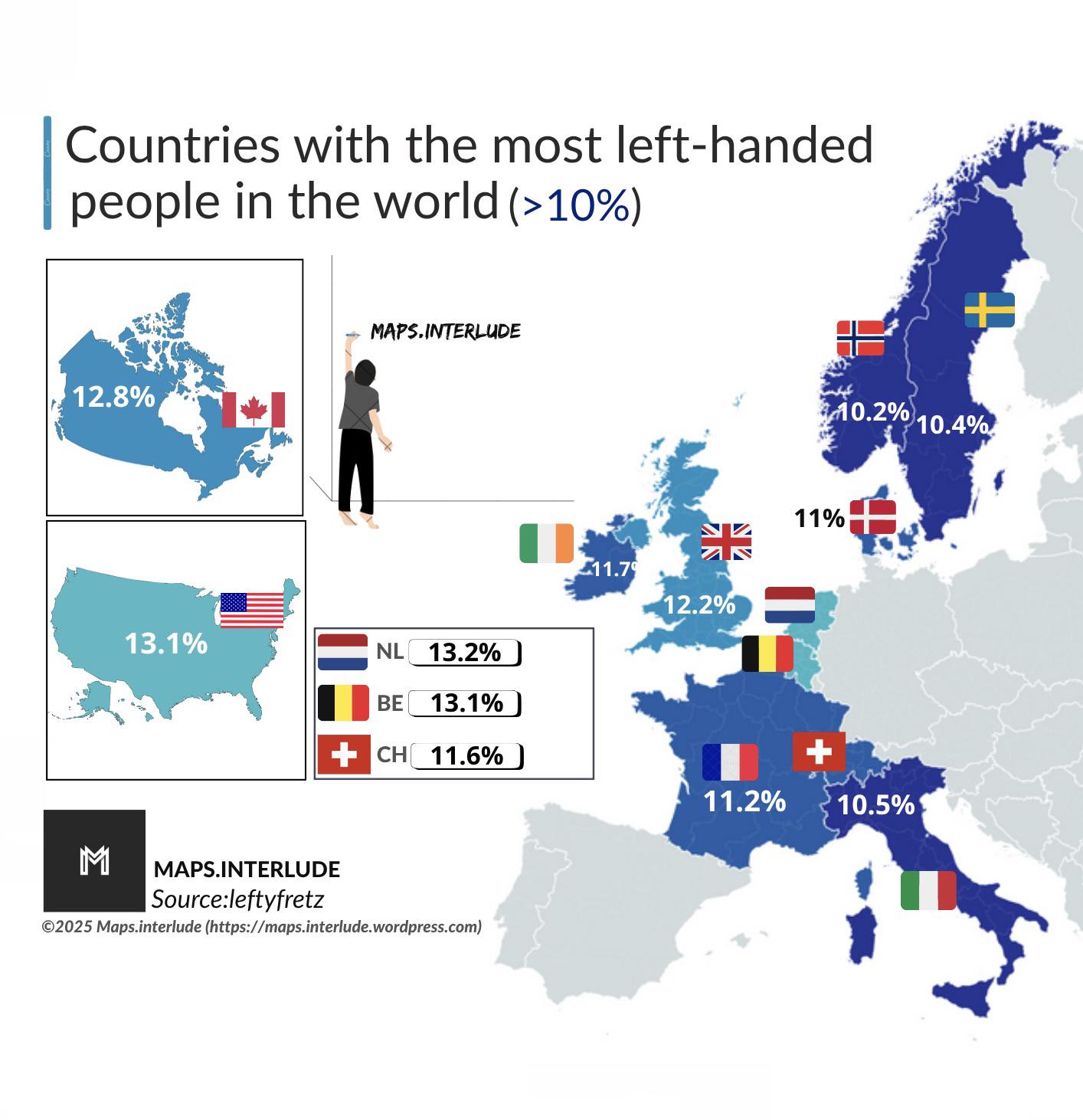Countries with the Most Left-Handed People Map


David Chen
Data Visualization Specialist
David Chen is an expert in transforming complex geographic datasets into compelling visual narratives. He combines his background in computer science ...
Geographic Analysis
What This Map Shows
The visualization titled "Countries with the Most Left-Handed People Map" illustrates the percentage of left-handed individuals in various countries across the globe. This intriguing map highlights a unique aspect of human diversity—our handedness. Interestingly, left-handedness affects approximately 10% of the world's population, but this distribution varies significantly by country. The map provides a clear view of which nations have the highest proportions of left-handed individuals, with notable figures such as Germany at 9.8%, Spain at 9.6%, Turkey at 9.2%, Finland at 8.3%, and Russia at 6.1%.
Deep Dive into Left-Handedness
Have you ever wondered why some people are left-handed? Left-handedness is believed to be influenced by a combination of genetic, environmental, and cultural factors. While the exact cause remains a topic of research, studies suggest that genetics play a significant role. For instance, individuals with left-handed parents are more likely to be left-handed themselves. However, the prevalence of left-handedness is not uniform across the globe.
Interestingly, cultural attitudes towards left-handedness can also impact its occurrence. In many cultures, being left-handed has historically been viewed negatively, leading to stigmatization. In some societies, left-handed children were even forced to use their right hand for writing and other tasks. This suppression could contribute to lower reported rates of left-handedness in certain regions.
Moreover, the brain's structure and how it processes information seem to be related to handedness. Left-handed individuals often exhibit a higher degree of creativity and divergent thinking, as their brain lateralization can differ from that of right-handed individuals. This has led to a higher representation of left-handed people in fields that require innovative thinking, such as the arts and sciences.
In addition to genetic and cultural factors, the social environment plays a crucial role. For instance, countries with a more accepting attitude towards left-handedness, like Germany and Spain, have higher percentages of left-handed individuals. In contrast, countries where left-handedness is still viewed with suspicion or as a disadvantage may report lower figures. This dynamic makes left-handedness not just a biological trait but also a cultural phenomenon.
Regional Analysis
When we examine the map closely, it becomes evident that Europe has a notable concentration of left-handed individuals. Germany, at the top of the list with 9.8%, shows a societal acceptance of left-handedness that is reflected in its education and cultural practices. Spain follows closely with 9.6%, where left-handedness has been embraced, often celebrated in folklore and tradition.
Turkey, with 9.2%, also shows a high prevalence, which could be attributed to both cultural acceptance and evolving educational practices that respect individual differences. Meanwhile, Finland stands at 8.3%, a country renowned for its progressive education system that encourages children to learn in ways that suit them best, regardless of handedness.
On the other hand, Russia, with 6.1%, perhaps reflects a more conservative view on left-handedness. Historically, societal norms may have discouraged left-handedness, leading to a lower reported percentage. The trend in Russia may also signal a shift as understanding and acceptance of left-handedness evolve globally.
Significance and Impact
Understanding the distribution of left-handedness across countries is more than just a statistical curiosity; it has real-world implications. For educators and parents, recognizing the challenges faced by left-handed children can lead to more inclusive teaching methods. For instance, left-handed individuals often struggle with tools and instruments designed primarily for right-handed users, which can hinder their learning and creativity.
Moreover, as the world becomes increasingly globalized, awareness of handedness can influence product design, workplace ergonomics, and even sports equipment. Interestingly, brands that focus on inclusivity may see a positive impact on their reputation and market reach by catering to left-handed individuals.
In terms of future projections, as more societies embrace diversity and inclusivity, we may see a gradual increase in the acceptance and reporting of left-handedness. The conversation around handedness will continue to evolve, reflecting broader changes in societal attitudes towards differences and disabilities.
In conclusion, the map of countries with the most left-handed people serves as a compelling reminder of human diversity. It invites us to reflect on our social structures and encourages us to foster environments that celebrate differences, ultimately enriching our global tapestry.
Visualization Details
- Published
- October 7, 2025
- Views
- 48
Comments
Loading comments...